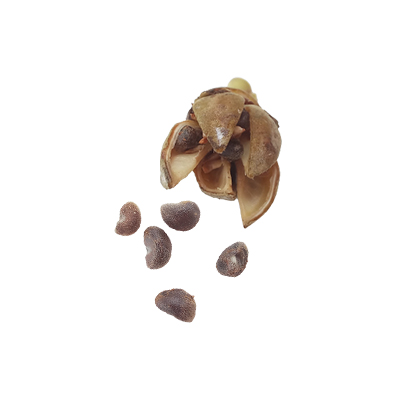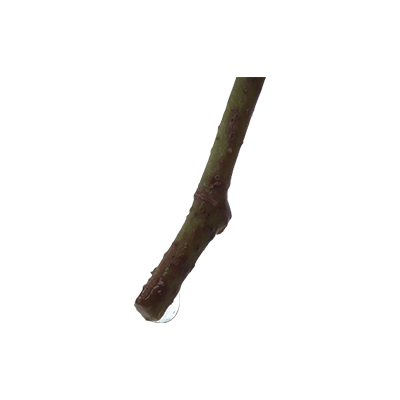Portia Tree
Thespesia populnea (L.) Sol. ex Corrêa
Malvaceae
Location in our garden
Principal
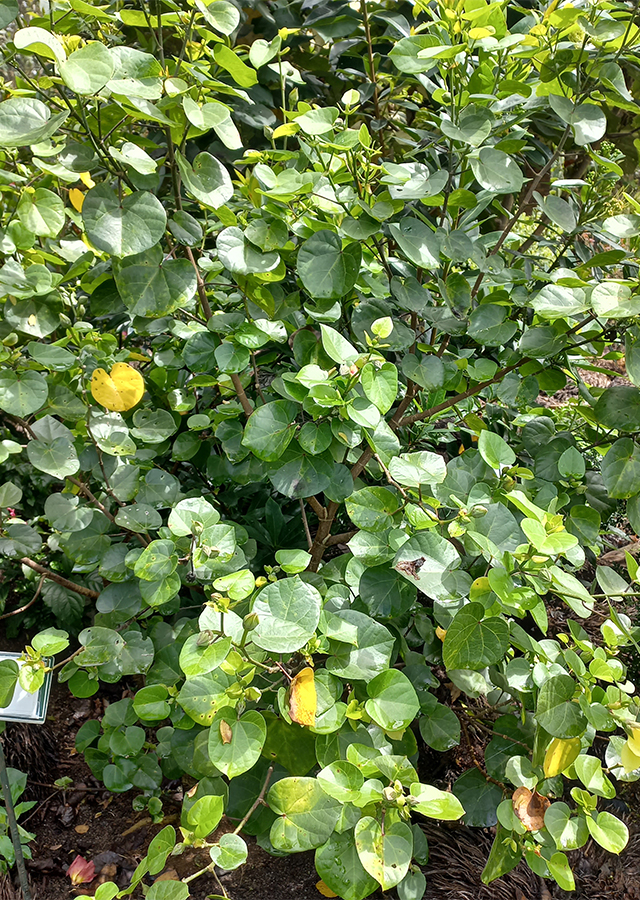
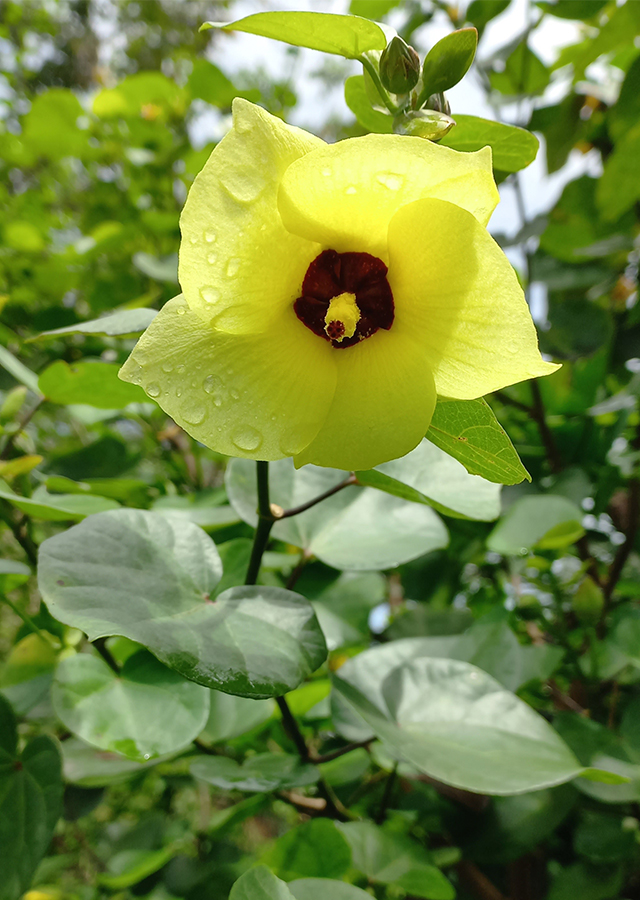
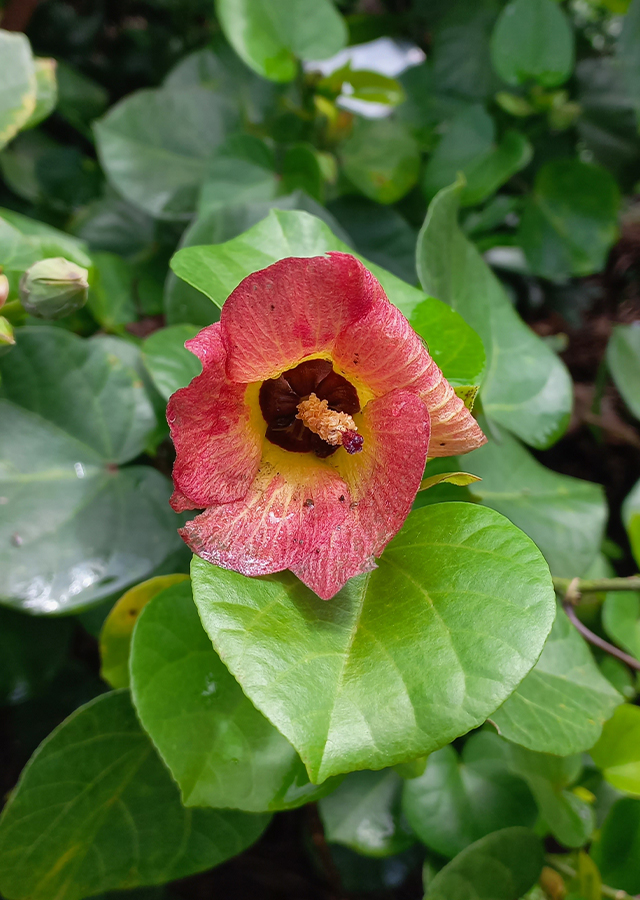
Synonym
Hibiscus baccifer G.Forst.
Bupariti populnea (L.) Rothm.
Malvaviscus populneus (L.) Gaertn.
Habitus
Shrubs. A fast-growing evergreen shrub or small tree with dense crown, and usually grows up 6 -10 m tall, although it has been recorded to be 20 m tall.
Part Used
Leaves
Seeds
Bark
Flowers
Fruit
Sap
Growing Requirements
Full Sunshine
Habitat
Riverbanks
Forest
Coastal
Roadside
Shrublands
Grassland
Terrestrial
Overview
Portia tree has a very broad native range and is widely distributed throughout the tropics, though it is most commonly found in coastal areas, in Central America, northern South America, the Caribbean, Africa, Asia, northern Australia, and on Indian and Pacific Ocean islands. However, other sources consider that portia tree as native to Asia, possibly also on Indian Ocean and Pacific island shores, and introduced and naturalized in the Americas. Portia tree is a multipurpose plant, which has many uses, including as a food, medicine, fiber source, wood source, wool dye, ornamental plant, shade and a coastal windbreak plant, and animal feed. In some Pacific Islands it is regarded as a sacred tree and was cultivated around temples, and its leaves are used in religious ceremony. Portia trees are the source of beautiful, strong and hard wood that is highly valued. It is used for a wide range of purposes including traditional bowls, artefacts, gunstocks, jewellery, furniture, plates and utensils, horse-drawn carts and wheelbarrows, to carve canoe paddles, and also used for light construction, flooring moulds, musical instruments, utensils and vehicle bodies. Since it is very durable under water, it is popular for boat building. A fruit extract and wood can be used as a dye, and the tough, fibrous bark yields a strong fibre used for cordage. Young leaves, flowers, flower buds and fruit are also can eaten as a vegetable. In adittion, portia tree is often used in traditional medicine, where the bark, leaves, flowers and fruits are all used to treat a range of ailments.
Vernacular Names
Alamo, Alamo blanco, Carana (Spanish), Arbre à tulipes, Arbre ombrelle (French), Bela-sombra, Pau-rosa, Tespésia (Brazil), Tong mian (China), Baum-Eibisch, Pappelblättriger, Küsten-Tropeneibisch (Germany), Arasi, Asha, Bhendi, Bhindi, Bugari, Dumbla, Gajadanda, Gajashundi, Galgaiavi (India), Banalu, Baru-baru laut, Bebaru, Buah keras lau (Malaysia), Sabu-bani (Myanmar), Banalo (Philippines), Pho thale, Po kamat phrai (Thailand).
Agroecology
Portia tree is a predominantly coastal species of tropical and warm subtropical climates. It is found in coral and sandy areas, along the edge of mangroves and in periodically waterlogged areas. It is also found in other coastal habitats, and further inland, but less frequently, in grasslands, bushland and forests, commonly up to 150 m altitude but also up to 500 m in eastern Africa and on some Pacific islands. It grows best in areas where annual daytime temperatures are within the range 20 - 30 °C, but can tolerate 10 - 35 °C. The plant can survive temperatures down to about 4 °C and the occasional very light frost. It prefers a mean annual rainfall in the range 1,000 - 3,000 mm, but tolerates 800 - 5,000 mm. This species is also prefer a moisture-retentive but well-drained soil and a position in full sun and does not grow well in shade. It also succeeds in dry locations and is highly tolerant of saline conditions. Prefers a pH in the range 6.5 - 8, tolerating 6 - 8.5. Established plants are very drought resistant and can tolerate a dry season of up to 8 months, and very wind-tolerant, withstanding even salt-laden winds.
Morphology
- Root - taproot.
- Stem - straight, branchless for up to 3 m, often twisted or bent, becoming hollow with age, without buttresses, with grey or light-brown bark, smooth or slightly fissured, becoming thick and rough, and inner bark pink to yellowish, tough and fibrous. Twigs glabrescent, green becoming grey with age, and covered with very small brown scales when young, as are leaf stalks, blades, flower stalks, calyx and fruits.
- Leaves - alternate, arranged spirally, blade orbicular, deltoid, ovate or oblong, simple and entire margins, shiny dark green on upper surface, paler beneath, slightly thickened and leathery, becoming nearly hairless, and usually with seven main veins from base, base cordate, apex acuminate.
- Flowers - bisexual, solitary, inserted at leaf axils. Calyx is cup shaped, green, remaining at the base of fruit, with 3-5 narrow green scales (bracts) on the ouside. Petals five, broad rounded oblique, 5 cm or more in length, pale yellow, usually with maroon spot at base, with tiny star shaped hairs on outer surface. Stamens many on column, joined at petals at base. Pistil has five-celled ovary with slender style and five broader stigmas. Older flowers will turning to purple or pink and will remain on the tree for few days.
- Fruits - capsules, brown, rounded but flattened, slightly five-ridged, dark grey, hard, woody and dry, contain yellow gum, and can split into 5 parts when ripe. Each part contains 3–4 seeds that are drop-shaped, densely covered by brown short hair.
- Seeds - several, elliptical, 1 cm long, brown hairy.
Cultivation
- Propagated by seed (generatively). Germination takes 8 - 70 days. Raising from seed is preferred as then the timber is knot free, straight, even grained and tough.
- Propagated by cutting (vegetatively). Cuttings of all sizes strike well, but it is preferable to plant small cuttings as trees raised from large cuttings are said to be short lived and liable to decay.
Chemical Constituents
Phosphoric acid, sesquiterpenoids (populene AH), sesquiterpenoid quinones (mansonone D and H, thespone, and thespesone), tannins, phenols, flavonoids, terpenes, saponins, alkaloids, steroids, coumarins, anthraquinones, amino acids, glycosides, cardiac glycosides, anthocyanides, gallic acid, catechins, myricetin, protocatechuic acid, epigallocatechin gallate, rosmarinic acid, ellagic acid, rutin, naringenine.
Traditional Medicinal Uses
- Decoction of bark used internally as alterative, externally as an embrocation and also used for washing skin diseases. A cold infusion of the bark is used in treating dysentery, diabetes, gonorrhoea, yellow urine, and thrush. Indigestion, pelvic infection, dysmenorrhoea, infertility, secondary amenorrhoea, appetite loss, ulcers and worms are also treated with the bark.
- The inner bark is used to treat constipation and typhoid.
- In India, ground bark used to treat skin diseases, and in Mauritius, bark is considered depurative and as treatment for dysentery and hemorrhoids.
- The stem is employed in treating breast cancer.
- Heartwood used as remedy for bilious attacks and colic, the Malays use it for pleurodynia.
- Leaves applied to inflamed and swollen joints, and decoction of leaves used as emollient for itches, treating coughs, influenza, headache and relapses in illnesses. Yellow sticky sap used to treat ringworm in India.
- A leaf tea is taken as a treatment for rheumatism and urinary retention.
- In Fiji, decoction of leaves used for coughs and headaches.
- Leaf and bark decoctions are taken as a remedy for high blood pressure and used for treating fevers in teething children.
- Flowers used for itches.
- Juice of fruit used for herpetic diseases and warts. In India, juice of fruit is used as external application for psoriasis.
- Juices from the pounded fruits, mixed with pounded leaves are used in a poultice to treat headaches and itches.
- The cooked fruit, crushed in coconut oil, provides a salve, which, if applied to the hair, will kill lice.
- Seeds are purgative.
- Studies have suggested wound healing, antinociceptive, anti-inflammatory, cognitive, hypolipidemic, antibacterial, memory-enhancing, antipsoriatic, antioxidant, hepatoprotective, anti-implantation, anthelmintic, cytotoxic, antidiabetic, chemopreventive, α-amylase inhibitory, antisteroidogenic, antiarthritic, analgesic, anticancer properties.
Part Used
Reference Sources
- CAB International. 2021. Invasive Species Compendium: Thespesia populnea (portia tree). https://www.cabi.org/isc/datasheet/53592#tosummaryOfInvasiveness. 11-11-2021.
- Useful Tropical Plants Database. 2021. Thespesia populnea. http://tropical.theferns.info/viewtropical.php?id=Thespesia+populnea. 11-11-2021.
- Flora Fauna Web. 2021. Thespesia populnea (L.) Sol. ex Corrêa. https://www.nparks.gov.sg/FloraFaunaWeb/Flora/3/1/3190. 11-11-2021.
- Stuartxchange. 2020. Phillipine Medicinal Plants: Banago. http://www.stuartxchange.org/Banago.html. 11-11-2021.



